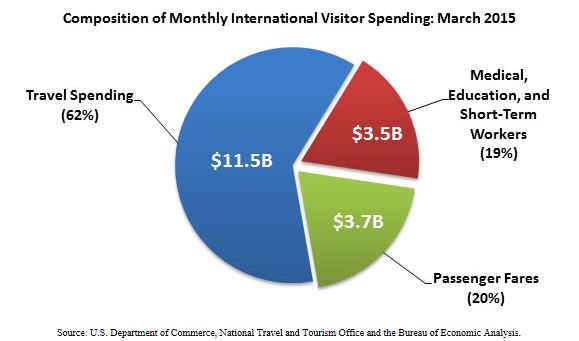WASHINGTON – May 21, 2015 – U.S. Under Secretary of Commerce for International Trade Stefan M. Selig today announced new data that show international visitors spent an estimated $18.6 billion on travel to, and tourism-related activities within, the United States during the month of March, an increase of 2 percent when compared to March 2014.
“Travel and tourism remains an important export for the United States. In 2014, tourism-related exports reached a record high of nearly $221 billion,” said Under Secretary Selig. “Continued growth in this important services industry will support even more American jobs.”
Travel and tourism is the largest services export for the United States, supporting more than 1.1 million U.S. jobs.
- Travel Receipts: Purchases of travel and tourism-related goods and services by international visitors traveling in the United States totaled $11.5 billion during March, virtually unchanged (0.4%) when compared to last year. These goods and services include food, lodging, recreation, gifts, entertainment, local transportation in the United States, and other items incidental to foreign travel. Travel receipts accounted for nearly 62 percent of total U.S. travel and tourism exports during March 2015.
- Passenger Fare Receipts: Fares received by U.S. carriers from international visitors totaled $3.7 billion for the month, an increase of slightly more than 2 percent when compared to March 2014. Passenger fare receipts accounted for nearly 20 percent of total U.S. travel and tourism exports during the month.
- Medical/Education/Short-Term Worker(1): Expenditures for educational and health-related tourism, along with all expenditures by border, seasonal, and other short-term workers, totaled $3.5 billion in March, an increase of nearly 7 percent when compared to the same period last year. Medical tourism, education, and short-term worker receipts accounted for 19 percent of total U.S. travel and tourism exports during March 2015.
Year-to-date international visitor spending is up nearly 3 percent in 2015, totaling $56.2 billion for the first three months in 2015. Conversely, U.S. resident spending abroad is up nearly 10 percent during the same period (January through March), having spent nearly $38.3 billion on imported travel and tourism-related goods and services, resulting in a proportionate decline in our balance of trade surplus. In fact, the United States enjoyed an $18.0 billion trade surplus for travel and tourism through March, down 9 percent when compared to the same period last year.
__________
(1) In June 2014 the Bureau of Economic Analysis (BEA) completed the most comprehensive restructuring of the U.S. international economic accounts since 1976 in an effort to bring our international accounts into closer conformity with international guidelines. As a result, BEA now uses a broader definition of travel that includes education-related and health-related travel and expenditures on goods and services by border, seasonal, and other short-term workers. To learn more, please visit: http://travel.trade.gov/pdf/restructuring-travel.pdf


